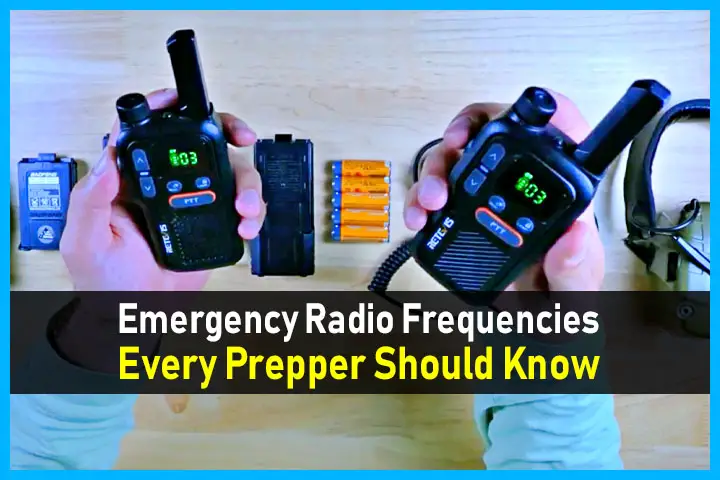Estimated reading time: 16 minutes
It’s not uncommon for many people to have radios on hand for emergencies. In some instances a radio is purchased and diligently stored for “someday.”
In other instances people actively use them when camping, hiking or on a fishing trip. But for the most part, a lot of us see a radio in storage or on hand as something we’ll figure out when we need it. That may not be the best idea.
Want to save this post for later? Click Here to Pin It On Pinterest!
There Can be More to Emergency Radio Communication than Just Turning it On

Our first response in an emergency would probably be to dial 911. Then again, the whole argument for using a radio for emergency communication is when everyday things like 911 fail.
There’s no shortage of natural and manmade disasters that cause power outages, and any outage of a long duration will eventually take down cell phone towers and other infrastructure that makes most modern communication work.
The Internet May be Unreliable as Well

An outage can affect the Internet and there are other threats from cyberattacks to EMP’s that could cause the Internet to fail. One last ditch Internet effort sometimes discussed is the use of hard-wired phone lines. They may actually work during an outage and in most areas, a 911 call will go through – or not.
When Radios are Our Only Option

It’s during desperate times that radios may emerge as the best and only option for communication. But here again, there’s more to it than just turning it on although that can sometimes work. What’s missing from that “just turn it on” mindset is the opportunity to not only tap into information about a disaster affecting your area, but to directly ask for help in an emergency.
In order to do any of that it helps to know where to find the information and most importantly, the help. That’s why it’s worth learning about and keeping a record of emergency radio frequencies.
Understanding The Range of Emergency Radio Frequencies

The full range of emergency radio frequencies are surprisingly large and reach across a variety of resources on a federal, state and local level. They also vary depending on every possible location from land, sea to air. Complicating matters is the fact that some frequencies are limited to certain types of radios.
Knowing the emergency frequencies for HAM radio is worthless to someone trying to find help with a CB radio or even some of the other radio types. What’s important to remember is that emergency frequencies vary depending not only on location but the type of radio equipment.
Another factor to remember is that some radio frequencies are not intended for direct communication with the general public. You can listen but you can’t join the conversation with the Coast Guard or even on some local police frequencies. We’ll identify the frequencies that are intended for emergency use by the general public and highlight those frequencies that are restricted to a particular service or group.
Megahertz 101

Radio transmissions over channels or bands as they’re sometimes called are measured in megahertz. Megahertz stands for one-million cycles per second and is the standard unit of frequency measurement for radio signals. In the simplest terms, one megahertz = one-million cycles. It basically denotes the speed that a signal moves through any given space.
The abbreviation for megahertz is MHz. What megahertz measures is the frequency of a radio wave. The frequency is how many radio waves pass a fixed point in one second. The time it takes for that wave to pass that one point is called a “hertz.” A million waves passing that point in a second is a “megahertz” and yes, there are lower amounts measured in kilohertz and higher amounts measured as gigahertz.
If that all sounds really fast, it is. And while that may be news to some of us, the concept of megahertz as a unit of frequency measurement is also news for others. That’s because it’s not commonly used in everyday life.
Car Radio Secrets

If you listen to your radio in the car you probably have a favorite channel. Let’s say it’s AM 780. The station probably has call letters like WBBM and they often refer to that number 780. What they never say is that the 780 stands for 780 kilohertz. That’s the radio frequency assigned to that station by the FCC.
Maybe you choose to listen to FM radio in the car. This time your favorite channel is 94.7. It too has call letters like WLS that they sing in a jingle throughout the day. What they don’t tell you is that 94.7 stands for 94.7 megahertz. That’s the radio frequency assigned to that FM station by the FCC.
The entire FM radio band has a range from 88.0 to 108.0 megahertz. Your favorite FM radio station is probably somewhere in that range. What’s important to know is that all radio bands have a fixed range. Somewhere in those ranges are those elusive emergency channels defined by megahertz that we’re about to cover.
Every Broadcast is All About hertz
Any radio signal for anything depends on radio waves to function from radio to traditional TV’s to cell phones. The ability of the FCC and other agencies around the world to manage, moderate and assign frequencies is what makes something like emergency frequencies possible.
Any assigned frequency is intended solely for the use of certain entities whether it be an FM rock and roll radio station or a broadcast from the Emergency Alert System.
Finding the Frequencies

Sometimes this is simple and sometimes it takes a bit of patience. A good example is channel 9 on a CB radio. Channel 9 is the dedicated emergency channel for CB’s. What most CB radios aren’t displaying is that channel 9 is broadcasting at 27.065 megahertz.
No one is asking you to carefully turn a dial to 27.065, they just assigned it the number 9 across the 40 CB radio channels. In case you’re interested the frequency band range for CB radios is 26.965 to 27.405 MHz across those 40 channels.
Many walkie-talkies or 2-way radios also use a channel numbering system in place of specific MHz numbers. But as you’ll see, the simpler the radio and it’s functionality the more limited it’s range in terms of miles reached and its ability to effectively achieve emergency communications.
From the Simple to the Complex

Some radios are easy to use like conventional 2-way walkie-talkies. You turn them on and push a button and talk.
Other radios like HAM radios are more complex requiring training, classes and a test to be licensed for their use.
How complex any radio needs to be depends a lot on the user and their situation. The best all around emergency radio is a HAM radio but we’ll cover other radio types that may suit your purposes and are easier to use and more affordable. All of them have specific emergency frequencies to varying degrees and some are preset or can be programmed to automatically find those frequencies.
Choosing a Radio Type

It’s unreasonable to buy ever type of radio on the market. If you already own one you are probably familiar with it and ideally have used it to discover all of its features and possibilities. What’s important is to understand how and where to find the emergency frequencies or bands on any radio.
Most of the radios we’ll cover are intended for 2-way communication. There are other radio types that you may be familiar with used primarily for broadcasting including AM and FM radios.
Other radio types have emerged for broadcasting using technologies like the Internet and Satellites but we’re going to primarily keep our focus on radios for 2-way communication that also broadcast information about emergency situations.
Here’s a brief overview of the types of radios that can be used for emergency communication. We’ll go into more detail in a chart that compares features and frequencies later in this article.
√ (FRS) Family Radio Service

These are the basic two-way radios. They are sometimes referred to as “walkie-talkies.” They are primarily used for 2-way communication for a variety of occasions from outdoor activities to general communication. The range is limited up to 2 miles and they don’t require a license. They’re also relatively inexpensive.
√ (CB) Citizens Band

Citizen Band radio is a radio type popular with truckers and used by many for general communication. The range is also a bit limited depending on the aerial size and the terrain but can broadcast as far as 20 miles, but usually is limited to a 2 to 3 mile range. CB radios also don’t require a license to operate.
√ (NOAA ) Weather radio

NOAA or weather radios are not intended for 2-way communication but broadcast constant weather reports and updates every 5 minutes. They can receive NOAA forecasts from just about any location due to the fact that NOAA has so many transmitting points.
√ (MURS) Multi-Use Radio Service

A MURS radio is a variation on the standard walkie-talkie with an extended range up to 10 miles. It doesn’t require a license and operates on 5 VHF frequencies. It’s also more expensive than a traditional walkie-talkie and a bit more complicated to use.
√ (VHF) Very High Frequency Marine Radio

The VHF Very High Frequency Marine Radio is the standard radio used by boaters. It largely depends on the line-of-sight transmission possible on open water. The average range is 5 to 10 miles up to 20 miles under ideal conditions.
While it has a longer range than a standard CB radio it does not tolerate any obstruction or obstacles such as tall buildings or mountains as well as some CB radios can. Fortunately, most open water avoids those obstacles and the extended range makes it preferable over a CB on open water.
√ (GMRS) General Mobile Radio Services

A GMRS is a step up from FRS or Family Ready Services but often used for recreational activities and business communication from construction sites to surveying. They require a license and have a significantly longer range than the more common 2-way walkie-talkies.
The range varies depending on terrain from a low of 2 miles up to 30 miles. Wattage also affects effective range with 15 watts identified as ideal.
√ Shortwave Radio

Shortwave radios are not designed for 2-way communication but can actively monitor a broad range of radio frequencies from around the world. It’s another good all-around choice and they are relatively inexpensive. They also do not require a license for use.
√ (HAM) Amateur Radio

Amateur radio is the gold standard for emergency communication. The units are available as handheld or base units and are expensive. They also require a license to operate.
The advantage is their remarkable range. With a proper antenna and the right conditions the signal can be bounced off the ionosphere to enable worldwide communication. It is also the primary emergency radio around the world, and offers multiple emergency frequencies in a large variety of languages and locations.
√ Police Scanner

A police scanner radio receives a range of communication from police, fire and emergency services. It is not intended for 2-way communication. Some of the messages are encrypted but many are not and can be monitored with a police scanner radio.
Radio Options and Features
Here’s a chart with the different types of 2-way radios, their range, average price; emergency frequencies and license requirements in some instances, The radios are listed from the simplest to the most complex and the license column is indicated with an “L”.
2-Way and Other Radio Emergency Frequencies Intended for Use by the General Public
Note: Range can vary depending on terrain, weather, antenna size and even sunspots.
Family Radio Service (FRS), Basic 2-Way Radios
- Usage: Recreational, construction sites, neighborhood communication
- Range: 1 to 2 miles
- Average Price: $15 to $40
- Emergency Frequencies: Channel 9 (462.6125 MHz) and Channel 20 (462.6750 MHz)
- No license needed
Citizens Band Radio (CB)
- Usage: Travel, recreation, general radio communication
- Range: 2 to 20 miles
- Average Price: $50 to $200
- Emergency Frequencies: Channel 9 (27.065 MHz)
- No license needed
Weather Radio (NOAA) – Not a 2-way radio but critical for emergency information
- Usage: All occasions, weather specific to location every 5 minutes
- Range: 40 miles
- Average Price: $24 to $75
- Emergency Frequencies: Varies by state. Click this link to locate your state. Or try: (162.400 MHz) (162.425 MHz) (162.450 MHz) (162.475 MHz) (162.500 MHz) (162.525 MHz) (162.550 MHz). Also auto tunes in some locations
- No license needed
Multi-Use Radio Service (MURS)
- Usage: Recreation, travel, construction, surveying w/ longer range than FRS
- Range: Up to 10 miles
- Average Price: $70 to $300
- Emergency Frequencies: 5 channels (151.820 MHz to 154.600 MHz)
- No license needed
Very High Frequency Marine Radio (VHF)
- Usage: Marine use on boats, civil aviation emergencies and others
- Range: 2 to 20 miles
- Average Price: $100 to $400
- Emergency Frequencies: (121.5 MHz)
- No license needed
General Mobile Radio Services (GMRS)
- Usage: Commonly used for recreation and business activities.
- Range: 10 to 15 miles
- Average Price: $25 to $100
- Emergency Frequencies: Channel 22 (462.7250 MHz)
- License required
Shortwave Radio
- Usage: Predominantly used to monitor a broad range of frequencies across all radio types
- Range: Worldwide depending on strength of signal received
- Average Price: $10 to $100
- Emergency Frequencies: There are hundreds of emergency channels that can be monitored. Follow this link to determine which frequency is best for you.
- No license required
Amateur Radio (HAM)
- Usage: Global communication and a primary resource for emergencies. License required.
- Range: Potentially worldwide
- Average Price: $300 to $3,000
- Emergency Frequencies: Key Emergency frequencies include: (3.940 MHz) (7.250 MHz) (14.300 MHz)
- License required
Police Scanner
- Usage: Local police communication although some frequencies may be encrypted. Not intended for 2-way communication.
- Range: Range averages about 30 miles for most scanners
- Average Price: $100 to $300
- Emergency Frequencies: Frequencies vary widely by region, state and county. Use this link to find a frequency for your location.
- No license required
Don’t Wait for the Worst
If you have a radio and haven’t learned about its capabilities and its available emergency frequencies, take the time to become familiar with them. If you’re considering a radio for backup communication in an emergency, think about what you can afford and what you’ll need.
The best choice for many is HAM radio, but the other options we presented will at least give you a good chance at knowing what’s going on when you need it most.
Like this post? Don’t Forget to Pin It On Pinterest!









Leave a Reply